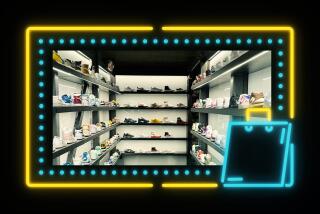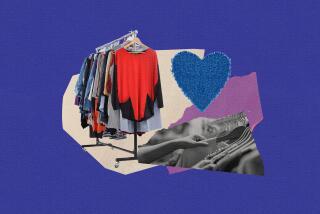Can We Shop?
- Share via
For Laurie Lackey, the defining moment of her infatuation with the QVC shopping channel came when she met the Queen of QVC, Joan Rivers.
Lackey, who has purchased 50 pieces of the Joan Rivers Classics jewelry collection from the shopping channel, wore a few of Rivers’ pieces to a benefit attended by the comedian at Mission San Juan Capistrano.
A freelance photographer, Lackey waited until Rivers was well within range and then called out, “Joan, I’m wearing your jewelry!” Rivers immediately broke away from a media horde to gush over Lackey’s bracelets, earrings and pendant.
“I think she was almost as excited to see me wearing her jewelry as I was to see her,” Lackey says.
Lackey is just the kind of shopper that QVC, the Home Shopping Network, infomercials and other TV shopping shows are trying to hook: a person who enjoys indulging in jewelry, designer clothing and other niceties but has trouble making it to the mall.
“I have a 3-year-old boy, and that makes it difficult to walk through Nordstrom,” Lackey says.
So, although the Laguna Hills resident lives close to some of the greatest shopping venues in the country, she prefers to tune in to QVC. About twice a month, she calls in an order for clothing, housewares or jewelry.
“My friends tease me. They think all I do is sit around ordering things from the TV,” she says.
Lackey is typical of the growing number of TV shoppers who belong to what QVC calls the “affluentials” or “landed gentry.” They don’t fit the TV shopper stereotype, someone tuning in to alleviate boredom by maxing out their credit cards. Instead, they’re middle- to upper-income customers who have a shortage of time, not cash.
QVC’s 5 million active customers (those who have made at least one purchase in the past year) rank above average in income. Compared with the American population, there’s a higher percentage of households in the $50,000 to $100,000 range among its TV shoppers. QVC’s customers are ‘disproportionately upscale” because its merchandise falls under the wants rather than needs category, and that requires buyers to have disposable income.
To attract affluent viewers, shopping shows have upgraded their mix of merchandise. Forget Ginsu knives and slice-’em, dice-’em kitchen appliances. Shoppers can order everything from a Bob Mackie gown to Nolan Miller jewelry by tuning in.
“There’s a stereotype of the TV shopper. Our customer is not interested in cheapie things,” says Amy Ferracci, spokeswoman for QVC in West Chester, Penn. “Something can cost $3,000, but it needs to look it.”
As proof, she sites the recent debut of QVC’s new Fendi footwear program. During the first show, six of the nine shoe styles featured sold out, at prices ranging from $70 to $250 a pair.
One sign that the percentage of higher-income viewers is growing: Fine gold jewelry has eclipsed cubic zirconia as QVC’s No. 1 selling category. In April QVC launched Arte d’ Oro, a line of 18-karat gold Italian jewelry. Even at prices of $600 to $3,000 per piece, the collection blew out.
“We not only sold out, but we had to end the program 20 minutes ahead of schedule,” Ferracci says.
The Home Shopping Network, meanwhile, unveiled a fashion collection by Diane Von Furstenberg in April that raked in $1 million in sales during its three-hour premiere.
Lackey likes to buy fashion jewelry from QVC because the quality of the merchandise fools even veteran jewelry wearers. One Orange County socialite, who wears plenty of the real thing, went gaga when she spotted Lackey wearing a QVC watch with a gold link strap and Bulgari-style heart-shaped earrings.
“You must be doing well,” she cooed.
Lackey says friends always look surprised when she tells them she ordered the pieces on TV, and that they cost $40 to $60.
“I tell people, ‘If you knew how much this cost you’d die.’ ”
She says she finds good deals on QVC, with prices “less than department stores but not as good as a discounter if they carried the same merchandise.”
Women make up the majority of TV shoppers (82% according to the Home Shopping Network), but men also watch and shop.
John Colleluori of Rancho Santa Margarita shops via TV because he’d rather flick on his remote control than go to a mall. He’s planning to avoid the hassle of holiday shopping by ordering presents in July. One year he bought a porcelain doll for his daughter.
“My daughter is a teen, so it’s harder for me to run from one end of the store to the other and buy her something without her seeing. She’s peeking into every bag. It’s hard to fool the kid,” Colleluori says. ‘This way, she’s quite astonished.”
When Debbie Konieczny of Foothill Ranch isn’t taking care of three children or working at her job as a medical assistant, she likes to unwind in front of the TV a couple of times a week and shop.
She buys all kinds of things--housewares, craft supplies, toys, figurines and “froufrou jewelry.”
“They are things you can’t find in a local mall,” she says. “I’ll be at a store and the cashier will say, ‘Where did you get that ring? It’s gorgeous.’ ” Konieczny finds shopping shows to be entertaining and informative.
While shopping shows tout their convenience (that’s what the C in QVC stands for, Ferracci says, while the Q and V are for quality and value), viewers also tune in for the companionship.
“You get to know the hosts. You follow their pregnancies and divorces,” Lackey says. “It’s like a girls’ night out.”
Tune into a shopping channel and you have an instant friend, a chummy host who will tell you jokes and share small tidbits about their friends and family while encouraging you to treat yourself to something like a cubic zirconia pendant.
Veterans of TV shopping shows keep their phones within reach to snap up an item before it sells out. They know if something’s really hot, it can be gone in two minutes.
Lackey can speed-dial the QVC automated service line using her Q-member number and charge her order on her Q-Card.
“Yes, in Orange County we have South Coast Plaza,” she says. “But this is right there on the screen.”
More to Read
Inside the business of entertainment
The Wide Shot brings you news, analysis and insights on everything from streaming wars to production — and what it all means for the future.
You may occasionally receive promotional content from the Los Angeles Times.










